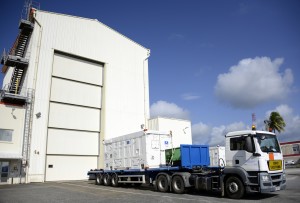Ninth and tenth Galileo satellites have crossed the Atlantic, touching down in French Guiana ahead of their joint launch this September. The delicate navigation satellites made their journey within environmentally controlled containers, having passed a gamut of tests to confirm their readiness for space.
The pair left ESA’s ESTEC technical centre in Noordwijk, the Netherlands, last Thursday by road to Luxembourg Findel Airport. On Friday morning the duo flew by Luxair 747 aircraft to Cayenne–Félix Eboué Airport in French Guiana, touching down at around midday local time.
They were then taken by road to the Guiana Space Centre, before being unboxed within an air-conditioned cleanroom, marking the start of their launch campaign.
September 10th launch on a Soyuz rocket will see Europe’s own satnav constellation reach double figures. These are Flight Models 5 and 6 of the Full Operational Capability version.
Two more satellites are still at ESTEC, midway through being tested. Fourteen more are being built at OHB in Bremen, Germany, with their navigation payloads coming from Surrey Space Satellite Technology in Guildford, UK, and parts supplied from across Europe.
Initial fit-check
During activity inside the Spaceport’s S1A clean room facility, Arianespace confirmed the correct fit for the Galileo spacecraft on their specially-designed payload dispenser, which will hold the satellites in a side-by-side configuration atop Soyuz’ Fregat upper stage during the mission and deploy them at the orbital insertion point.
As part of this process, the spacecraft are installed separately, then removed from the RUAG Space Sweden-built dispenser that uses a pyrotechnic separation system to release them in opposite directions during the flight.
Completion of the fit-check allows the next stage of payload preparations to begin, including fueling, final integration with the payload dispenser, and the completed unit’s subsequent installation on Arianespace’s medium-lift workhorse Soyuz vehicle.



